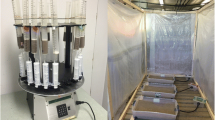Abstract
The Soil Liming Model (SLiM) has been used to simulate lake and stream water quality response to different strategies for the application of limestone to subcatchment soils in the Woods Lake, NY watershed. Simulations using doses of 3, 10, or 30 t ha−1 forecast that a dose in excess of 10 t ha−1 must be applied to discharge areas in order to sufficiently improve water quality in the lake. At 3 t ha−1 inlet stream water quality could support fish populations. As expected, treatment effectiveness is strongly influenced by subcatchment hydrologic flow paths. Where shallow flow predominates, soil liming provides a more effective tool for lake water quality improvement. In subcatchments drained primarily by ground water, the effect of liming on water quality is less pronounced albeit of longer duration. Based upon the results of these model simulations, the authors compare results of conventional lake liming to simulated watershed treatment predictions.
Similar content being viewed by others
References
Adams, T.B. and Brocksen, R.W.: 1988, Water, Air, and Soil Pollut. 41, 137.
Baker, J. and Schofield, C.L.: 1981, Water, Air, and Soil Pollut. 18, 289.
Booty, W.G.: 1983, Watershed acidification models and the soil neutralization concept. PhD thesis, MacMaster University.
Booty, W.G., DePinto, J.V. and Scheffe, R.D.: 1988, Water Resources Research 24, 1024.
Boyd, G.E., Adamson, A.W., and Myers, L.W.: 1947, American Chemical Society Journal 69, 2836.
Brocksen, R.W. and Emler, Jr., P.W.: 1988, Water, Air, and Soil Pollut. 41, 85.
Brown, D.J.A.: 1982, Water, Air, and Soil Pollut. 16, 343.
Chen, B.J., Gherini, S., Hudson, R.M., and Dean, S.: 1983, The Integrated Lake-Watershed Acidification Study. Final Report EPRI EA-3221, Electric Power Research Institute, Palo Alto, California.
Cussler, E.L.: 1984, Diffusion. Cambridge University Press, Cambridge (U.K.).
DePinto, J.V., Scheffe, R.D., Booty, W.G., and Young, T.C.: 1989: Can. J. Fish. Aquat. Sci. 46, 323.
Driscoll, C.T. and Bisogni, J.J.: 1984, Weak acid/base systems in dilute acidified acid and streams in the Adirondack region of New York State. In J.L. Schnoor, editor, Modeling of Total Acidification Precipitation Impacts, pages 53–72, Butterworth, Stoneham.
Helfferich, F.G.: 1983, Ion exchange kinetics — Evolution of a theory, in Liberti, L. and Helfferich, F.G. (eds), Mass Transfer and Kinetics of Ion Exchange, pages 157–179, Martinus Nijhoff Publishing, Boston.
Johnston, A.E., Goulding, K.W.T. and Poulton, P.R.: 1986, Soil Use and Management 2, 3.
Lake Acidification Mitigation Project: 1989, Can. J. Fish. Aquat. Sci. 46, 2.
Lasaga, A.: 1984, Journal of Physical Research 89, 4009.
Nielsen, K.F.: 1958, Canadian Journal of Soil Science 38, 114.
Plummer, N.L., Wigley, T.M.L. and Parkhurst, D.L.: 1978, American Journal of Science 278, 179.
Renberg, I. and Wallin, J.E.: 1985, Ecological Bulletins 37, 47.
Reuss, J.O.: 1983, Journal of Environmental Quality 212, 591.
Schreiber, K.: 1988, Water, Air, and Soil Pollut. 41, 53.
Schofield, C.L.: 1982, Historical fisheries changes in the United States related to decreases in surface water pH, p. 57–67 in Johnson, R.E. (ed) Acid Rain/Fisheries. American Fisheries Society, Bethesda, MD.
Sposito, G.: 1977, Soil Sci. Soc. of Amer. J. 41, 1205.
Sverdrup, H., Rasmussen, R. and Bjerle, I.: 1983, Chemica Scripta 24, 299.
Sverdrup, H. and Warfvinge, P.: 1985, Water Resources Research 21, 1373.
Sverdrup, H. and Warfinge, P.: 1987, Upplosning av kalksten och andra neutralisationsmedel i mark (Dissolution of Limestone and other Neutralizing Materials in Soils). Swedish Environmental Protection Board (SNV), Solna, Sweden, SNV Report 3311, ISBN 91-620-3311-5.
Warfvinge, P: 1988, Modeling acidification mitigation in watersheds. Department of Chemical Engineering, Lund Institute of Technology, 1988. Doctoral Thesis.
Warfvinge, P. and Sverdrup, H.: 1988, Soil Sci. Soc. of Amer. J. 53, 44.
Warfvinge, P. and Sverdrup, H.: 1988, Lake and Reservoir Management 4, 99.
Wright, R.F.: 1977, Historical changes in the pH of 128 lakes in Norway and 130 lakes in southern Sweden over the period 1923–1976. Technical Report, SNSF, NLH, Oslo-As, Norway, TN 34/77.
Young, T.C., DePinto, J.V., Rhea, J.R. and Scheffe, R.D.: 1989, Canadian Journal of Fisheries and Aquatic Sciences 46, 323.
Author information
Authors and Affiliations
Rights and permissions
About this article
Cite this article
Brocksen, R.W., Adams, T.B., Sverdrup, H. et al. Terrestrial liming as a tool to mitigate acidification of Woods Lake, NY. Water Air Soil Pollut 54, 509–527 (1990). https://doi.org/10.1007/BF00298690
Issue Date:
DOI: https://doi.org/10.1007/BF00298690




